If you’re considering growing hostas in pots, smaller sized hostas do very well in containers in the right potting soil, water, and sunlight ratios. Even giant hostas can grow in pots all you need is BIG pots.
Using small shrubs or perennials in containers has become very common as breeders come up with more compact plants and gardens shrink. Hostas are one group that does exceptionally well.
Growing hostas in containers is a simple task because they are easy to tend and come in thousands of options that make them the perfect plant for distracted, new, or busy gardeners.
When you’re growing hostas in pots, use a standard potting soil as the growing medium and water the plant into your pot. Never use garden soil and consider a fast-draining medium.
Set your container outdoors in a shady or partially sunny spot. Most hosta varieties prefer dappled shade with morning sun.
The complete answer is more complicated than this. This is why when people ask me how to grow hostas in containers, I always ask how much time they have.
There are so many things to consider, but the benefits are well worth it. If you’re interested in growing hostas in pots, let’s dive in!
Can You Really Grow Nice Hostas in Pots
The short answer is yes, but it’s not that simple. Yes, hostas can grow very well in pots under the correct circumstances. The payoff that I love about this method is that there are so many benefits associated with it.
Hostas can add splashes of texture and color to your garden or yard, but the hostas themselves have a limit of yellows, blues, and greens.
Containers have virtually endless color and texture combinations, and they’re very inexpensive if you purchase them at a second-hand store and paint them.
I see it like a treasure hunt when I look for new pots for my hostas because you never know what you’re going to find.
I can pick up my pots and move them, especially when I have a difficult space to fill by my stairs or in a corner by my fence.
They also let you put them in places that traditionally wouldn’t drain well enough to allow your hostas to thrive. You can create focal points with your prized hostas by plopping them onto your deck so they’re front and center for any visitors you have.
The amount of sun you expose the hosta too and type of hosta will dictate the color schemes you get. Dappled shade is the best thing for this plant, especially when it gets afternoon shade and morning sun.
Putting your hostas in containers gives you a quick and easy way to move them around to catch the perfect amount of sun with minimal effort.
I know I started out putting my hostas in a shaded garden bed, but it has hit or miss how well they did because of the sunlight exposure. Putting them in pots helped me ensure they would do very well.
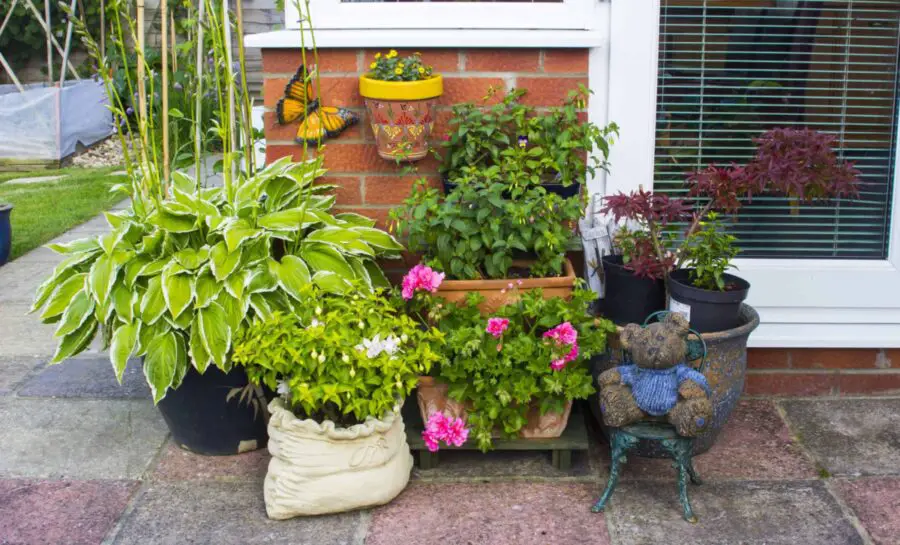
I’ve put hostas out in the full sun before and I noticed they got brown along the edges and dry during the hottest months during the summer. So, pots really helped me maximize their growth by making sure they got the best lighting conditions possible.
The container size in relation to your hosta size will matter too. Miniature hostas may only grow a few inches across, but large hostas can easily get between six and eight-feet wide.
Make sure you pay attention to the mature height and width of the particular hosta you want to buy because this will help you plan for the right container size. I’ve found that garden centers have good-sized boxes and pots in terracotta and plastic.
Plastic lasts forever, and it’s very hard to break. The pot’s width should be larger than the height.
Hosta roots will grow out laterally, and they should have space to spread out before they hit the container wall. It also takes much longer for the hosta to get root bound in wider pots, and this reduces your maintenance.
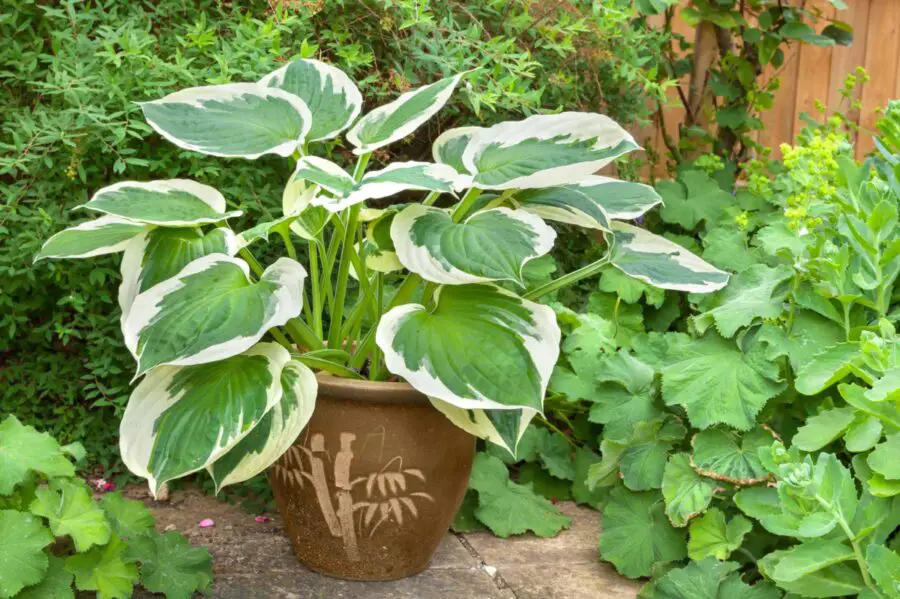
I’ve put hostas out in the full sun before and I noticed they got brown along the edges and dry during the hottest months during the summer. So, pots really helped me maximize their growth by making sure they got the best lighting conditions possible.
The container size in relation to your hosta size will matter too. Miniature hostas may only grow a few inches across, but large hostas can easily get between six and eight-feet wide.
Make sure you pay attention to the mature height and width of the particular hosta you want to buy because this will help you plan for the right container size. I’ve found that garden centers have good-sized boxes and pots in terracotta and plastic.
Plastic lasts forever, and it’s very hard to break. The pot’s width should be larger than the height.
Hosta roots will grow out laterally, and they should have space to spread out before they hit the container wall. It also takes much longer for the hosta to get root bound in wider pots, and this reduces your maintenance.
Hosta Container Ideals
You want to create a marriage of the perfect plants and containers when you plant hostas in pots. To do this, you want to know the correct hosta container ideals.
Small or miniature hostas are the most popular sizes that people purchase for planting and growing like this, and they’re very easy for beginner gardeners to care for. Several species include:
Cherry Tart—This small hosta grows up to 25-inches wide and 10-inches tall. You’ll get stunning chartreuse leaves that will slowly change to a vibrant yellow under bright lighting. Place this container at eye level to make the red petioles visible.
Fire Island—Fire Island hostas grow up to 15-inches high and 24-inches wide. The red petioles and acid yellow leaves give this plant a striking look.
Baby Bunting—This is a reliable clump-growing hosta species that gets 10-inches tall and 15-inches wide. It has heart-shaped blue leaves with bright purple flowers in the summer months.
Blue Mouse Ears—This is a dependable hosta species with rounded blue-tinged leaves. It gets up to five inches tall and nine inches wide with proper care, and it’s very hardy for beginner gardeners.
Little Treasure—If you want to tuck a hosta in a tight space between rocks, Little Treasure is perfect. It has tropical-inspired slightly twisted leaves in green with yellow stripes. It’ll grow up to 11-inches wide and 6-inches tall.
With mini hostas, I’ve found that one of the most common ways to get them to grow is by putting them in hypertufa troughs.
This trough uses a porous concrete mixture with peat moss to create a unique and breathable growing medium for the plant. If you care for it correctly, there’s no reason why you can’t use it year after year without it breaking down.
The container should be easy to drain, and you don’t want to set them directly on the ground because the drainage holes will plug. I like to set mine on paving stones, but you can also buy inexpensive feet for it.
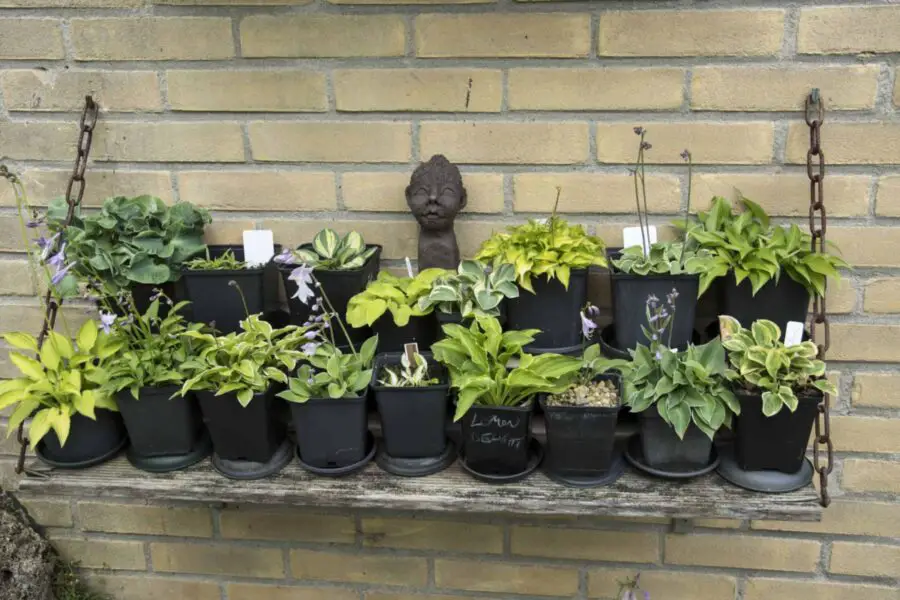
As long as you make sure your container can drain really well, you can get away with using less potting mix for a planting medium.
Add some organic material like peat compost and granular fertilizer to create a richer soil to feed your hostas.
Hostas are also one plant that loves water, so you want to water them really well after you plant them in your hypertufa trough or planter. You could even add a light layer of mulch to help retain the moisture to keep your plant happy.
Don’t let them sit in water, but water them very well. If you set them in a saucer, empty it every time you water or it rains. If you’re worried about drainage, add some pebbles to the bottom of the pot before you add the planting medium and the hosta itself.
Hosta Container Garden
What is a hosta container garden? Simply put, it’s a garden where all of your hostas go into pots or containers instead of in the ground. I like old iron animal troughs because I can set them up beside my walkway up to my house and fill them with small hostas.
But you don’t have to be very elaborate either. You could go smaller and choose individual containers for all of your hostas (but this can get overwhelming as you get a knack for it and have dozens of them).
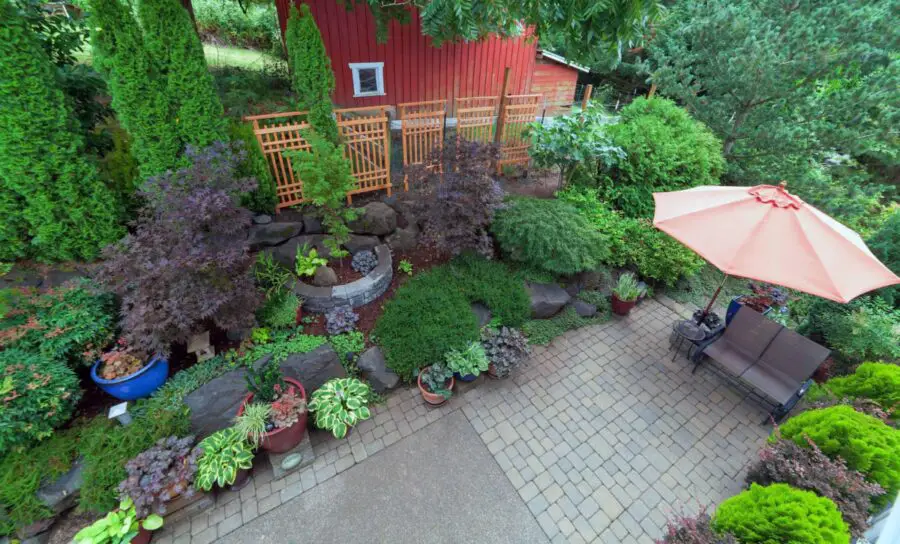
There are so many types of hostas you could put into one long trough, especially if you decide to go for the small or miniature varieties. I like:
Feather Boa
Kiwi Jordan
Lakeside Baby Face
Lakeside Lime Time
Little Wonder
Sunlight Child
Surfer Girl
These hostas won’t take over the trough or container. As a bonus, they come in a nice spectrum of colors to make it look unique and interesting. This is nice in the spring and summer months when everything starts to bloom and grow.
Planting Hostas in Pots
So, how do you plant hostas in pots, exactly? Luckily, it’s not rocket science. It’s not even remotely hard as long as you have the right materials handy.
Most gardeners will, even if your brand new. First off, you can start your hostas in containers from mature plants or bulbs. Once you decide how you want to plant them, move on to your container size.
Video: How to Plant Container Hostas
The container size will depend on the size of the hosta you have. When you pick out your pot, make sure you leave two or three inches of room between the pot wall and the plant itself. You pot them just like you would your house plants.
Look at the root ball and make sure that the pot is around one-inch better. You’ll most likely have to repot them in the spring, but this will give them a solid foundation to grow the first year and put down strong roots to keep the hosta healthy.
Double-check that there is adequate drainage in the pot because hostas like water, but they don’t enjoy sitting in water. I like to drill extra holes in the bottom of my containers to ensure they drain when I water them.
You don’t have to put rocks in the bottom of the container, but it’s an optional step if you’re really worried about over watering them.
Get high-quality, fresh potting mix. Avoid using garden soil because it’s too heavy. Potting mix also drains water better and absorbs it better than garden soil, and this helps feed your hostas so they can grow in this confined space.
Remove your plants from the container and gently pull off any large roots that wrap around the root ball. Pry the center mass apart and shake out the roots. Pop the hosta into your container and pack it with potting mix.
Add a light layer of mulch or sheet moss dampened with water across the top. Give your hosta a thorough watering and set it out in the shade.
Leave your hosta to settle for two to three weeks after you plant it, and then you can apply a 10-10-10 all-purpose fertilizer to give it a boost.

During the active growing season, you’ll water your hostas in containers every few days and fertilize every 30 days. You’ll wash a good bit of fertilizer away when you water, so don’t forget to replace it.
Best Pots for Hostas
Look at the hosta’s mature size guidelines when you pick out a pot. Hosta roots grow horizontally instead of vertically, so you want the pot to have a diameter that is no more than three-inches wider than the current root size.
The roots will have room to spread out and display the leaves. Putting a small hosta in a pot that is too big makes it prone to root rot.
You can buy large pots and nurseries, but anything that will hold soil and allow it to drain is fair game. Vintage strainers are a great option with a piece of landscape fabric in the bottom. Cut it to size and cut slits in the fabric and then add the soil to hold it in place.
Whatever you choose, make sure your plastic, terracotta, or vintage containers are big enough for the hosta clump. Get your hostas a larger pot every year until they reach their mature size.
Best Potting Mix for Hostas
What is the best potting soil for hostas? They need soil that offers excellent air circulation and good drainage. Bark, grit, and perlite make wonderful additions.
I like soil that has a mixture of particles sizes, and I like to add in pumice or bark chunks to keep the soil from compressing too much around the roots.
You can purchase mixes like this or you can add them in later. Miracle Gro is a great choice. You just have to ensure that it’s not too dense and heavy.
Best Hostas for Containers
What makes a good container hosta? Generally speaking, you want a hosta that will fit nicely into your container and stay relatively small. They’re hardy and add colors or texture to your yard.
Miniature or small hostas are very popular amongst veteran and beginner gardeners, and I know I have many sitting around. A few of my absolute favorites include:
Applitini
Cherry Tart
Corkscrew
Hideout
Little Treasure
Mouse Ears
Rainbow’s End
Tick Tock
One of my favorite containers for hostas is the Countryside Flower Box Planter . It’s a simple rectangular container that comes in four sizes and four colors. It has small feet, so it’s not sitting directly on the ground, and there are plenty of drainage holes.
The lightweight plastic design is very durable, and it won’t fade to keep it looking nice for years to come.
How to Care for Hostas in Pots
I told you how to set up your hosta, but there are a few quick things you can do to help keep it healthy. First, set the pot in an area in your yard that gets dappled sunlight. Make sure it’s not in the direct light because it’ll burn.
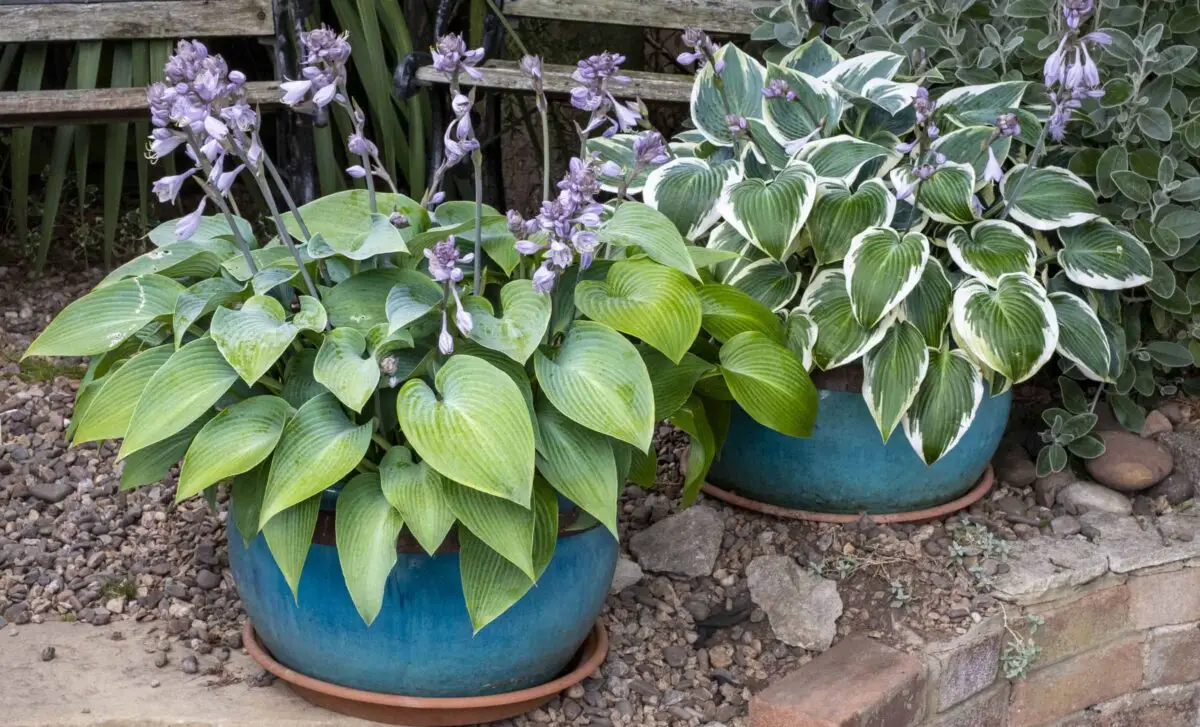
You’ll have to water them good when you first plant them and give them a few days to settle. Once they do, water them every two or three days thoroughly and make sure the drainage holes don’t plug.
Fertilize your hostas once a month and make sure that the soil doesn’t compact too much.
Fertilizing Potted Hostas
Feeding your hostas is a key factor to ensuring they grow thick and strong. If you’re wondering what kind of fertilizer to use, here’s the answer. Fertilize your hostas at least once a month because you’ll wash a lot of it away with the frequent waterings.
For the best results, use a water-soluble or slow-release fertilizer. You can also use a combination of both. Apply the fertilizer at the recommended rate on the package through the late summer. Also see Fertilizing Hostas In Containers for more details.
Don’t apply any fertilizer two months before your first frost date. You can resume fertilizing in the spring to encourage healthy growth.
How Often to Water Hostas in Pots
You’ll have to water hostas in containers much more than you would if you planted them the traditional way in the ground. Deeper watering encourages deeper and stronger roots, so water them every other day during the hotter months.
Most of the water will run right through the pot and drain out, so you have to make a point to water enough to keep the soil consistently moist.
Dividing Hostas in Pots
Once you plant your hostas in pots, they’ll need time before you divide or move them. However, compared to in-ground hostas, container hostas are a dream to divide. Summer is your best time to divide them.
Video: How to Divide Hostas in Pots
Once your hosta gets big enough that you have to repot it, remove it from the container, wash out the root ball, divide it, and put the newly divided plants into new containers with fresh soil and a thorough watering.
Overwintering Your Hostas in Pots
Since hostas are perennials, they need six weeks every year of temperatures below 40°F to rest and recharge for the new growth season. When temperatures get lower than that, you’ll have to protect them to keep the roots from freezing.
Smaller pots are more prone to freezing solid, so protection is absolutely necessary. If you have smaller pots, you can bury them all in the ground or put a layer of leaves over them.
Another option is to move your pots up next to a fence in the corner or in your garage. Once the freeze hits, you could put the pots on their sides. Larger pots typically overwinter very well because of their size.
You can bury it in the ground, but you can usually get away with adding a two or three-inch layer of mulch on the top of the pot and leaving it until spring. Water them lightly to prevent them from drying out.
For warmer climates, you could put them into a root cellar or in a cooler and dark basement to mimic the proper dormant requirements. They need to go dormant to grow each year.
Giant Hostas in Big Containers
Putting giant hostas in containers and having them grow works the same way as it does for small or medium-sized plants. The only difference is the container size and how you repot them.
When it’s time to repot, the easiest thing you can do is lay the pot on its side when the plant is dormant. Slide the smaller pot into the larger one and heave them upright.
Cut the smaller pot away from the plant, remove it, loosen your plant’s roots, and add new soil. Water it thoroughly. This can easily weight a few hundred pounds, so enlist a friend of two to help you.
Frequently Asked Questions
How Do You Winterize Hostas in Pots
ou can sink the entire pot into the ground, huddle smaller pots together and cover them with leaves, or you can move your hostas into a sheltered garage or in a fence corner.
Will Hostas Survive Winter in Pots
Yes, as long as you take the proper steps to winterize them to encourage them to go dormant and keep them out of the elements.
How Do You Split Hostas in Containers
Wait until it’s summer and your hostas need a bigger pot. Take them out, clean out the roots, split the plant into two or three pieces, and plant each piece in a new container.
Closing Thoughts
Hostas in containers are wonderful to have around your home, and I love that they’re great for beginner gardeners.
Watch your pot size, make sure it has great drainage, water it thoroughly, and fertilize it on a schedule while keeping your hostas in dappled shade. Doing all of this will increase your chances of having beautiful hostas in pots all season long!